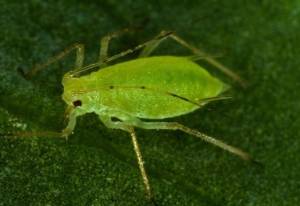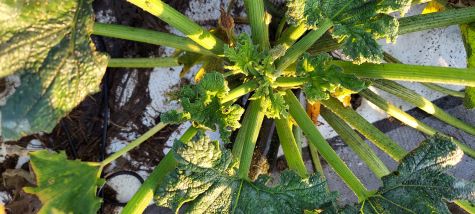Aphids on Vegetables

While we may not like the hot weather, several insect pests do, including this week’s insect: the aphid. Aphids are small, soft-bodied, pear-shaped insects with two tailpipe-like appendages called “cornicles”. The cornicles are unique to aphids and excrete defensive compounds. Aphids come in various colors and can be winged or wingless. These insects overwinter as eggs on woody hosts and hatch in the spring, producing only females. The spring green peach aphids then feed on the new growth of woody plants, and when mature, give birth asexually to live female offspring. One female can have up to 12 nymphs per day for 50 to 100 total offspring. After about 2 to 6 generations on the woody plants, the aphids grow wings and migrate to other plants, including perennials and vegetables, for the summer. As temperatures cool, aphids again form male and female winged offspring, and return to the woody plants where eggs are laid for overwintering.
Aphids feed by sucking sap from the plant tissues. This feeding distorts and stunts the plants while the honeydew aphids produce supports sooty mold growth. While the damage caused by aphid feeding hurts the plants, aphids are also a vector for multiple viruses. Monitoring your vegetables for aphids a couple of times a week is essential. Often, aphid infestations start with just a few scattered colonies throughout the field, so be sure to check everywhere, not just around the edges. With the heat, aphid populations are increasing faster than natural predators can keep them in check. You can attract natural predators by planting yarrow, alyssum, herbs, and other plants with small, attractive flowers for beneficial insects.
 If you find just a few aphids on your plants, it’s best not to treat until you reach threshold levels, as small populations of aphids will support the beneficial insect population and keep the population in check overall. Once your levels reach the threshold for your vegetable, then you can start treating. On small plants, when the aphid population is increasing, a general threshold level is found when aphids are found on 50-60% of the leaves, or if aphid populations remain at 8 to 10 or more per leaf for two or more weeks. On cabbage, broccoli, and cauliflower, start treating as soon as 1 to 2% of plants are infested. If you see just a few aphids, you can spray the plant down with a strong stream of water, which washes them off and kills them. Other control options include insecticidal soap and horticultural oils, which are options to treat aphids before the populations reach high levels. Once populations reach higher levels, products containing malathion, bifenthrin, cyfluthrin, or pyrethrin can be used to control the insects. Be sure to thoroughly cover all parts of the plant and all sides of the leaf. Be sure to read the label and make sure it lists the vegetable you are treating and the number of days after spraying before you can harvest the produce.
If you find just a few aphids on your plants, it’s best not to treat until you reach threshold levels, as small populations of aphids will support the beneficial insect population and keep the population in check overall. Once your levels reach the threshold for your vegetable, then you can start treating. On small plants, when the aphid population is increasing, a general threshold level is found when aphids are found on 50-60% of the leaves, or if aphid populations remain at 8 to 10 or more per leaf for two or more weeks. On cabbage, broccoli, and cauliflower, start treating as soon as 1 to 2% of plants are infested. If you see just a few aphids, you can spray the plant down with a strong stream of water, which washes them off and kills them. Other control options include insecticidal soap and horticultural oils, which are options to treat aphids before the populations reach high levels. Once populations reach higher levels, products containing malathion, bifenthrin, cyfluthrin, or pyrethrin can be used to control the insects. Be sure to thoroughly cover all parts of the plant and all sides of the leaf. Be sure to read the label and make sure it lists the vegetable you are treating and the number of days after spraying before you can harvest the produce.

Have questions? Contact our office where our Horticulture Extension Agent will assist you with questions.
Phone: (316) 321-9660
Email: callae@ksu.edu